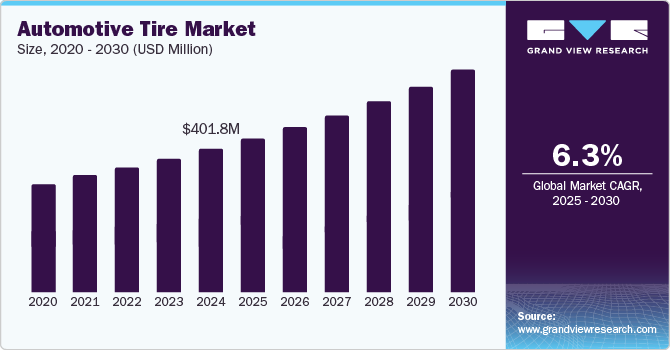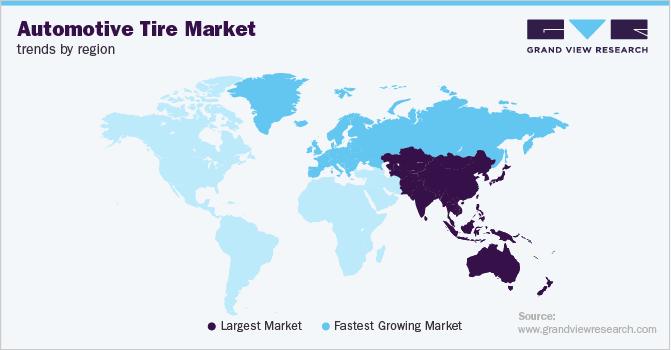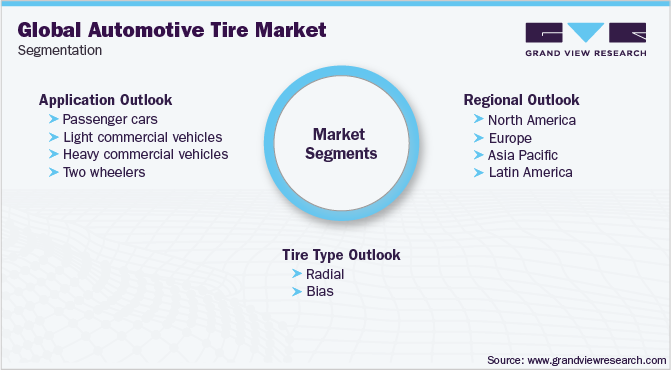- Home
- »
- Advanced Interior Materials
- »
-
Automotive Tire Market Size & Share Analysis Report, 2024GVR Report cover
![Automotive Tire Market Size, Share & Trends Report]()
Automotive Tire Market Size, Share & Trends Analysis Report By Type (Radial and Bias), Application (Passenger Cars, Light Commercial Vehicles, Heavy Commercial Vehicles and Two Wheelers) And Segment Forecasts To 2024
- Report ID: 978-1-68038-836-7
- Number of Report Pages: 67
- Format: PDF, Horizon Databook
- Historical Data: 2010-2012
- Forecast Period: 2016 - 2024
- Industry: Advanced Materials
Report Overview
The global automotive tire market size was valued at USD 227.7 billion in 2015 and is expected to grow at a compound annual growth rate (CAGR) of 6.6% from 2016 to 2024. Companies in the automotive tire space continuously focus on product differentiation by offering innovative technologies due to the competitive nature of the industry. The technology offers high levels of performance and durability, for example, the tread pattern self-regenerates as it is used, which means it can deliver a high level of grip even when worn.

Increasing sales for passenger and commercial vehicles across the globe is anticipated to drive the consumption for tires over the future. According to the OICA, the International Organization of Motor Vehicle Manufacturers, over 90 million new passenger and commercial vehicles were manufactured in the year 2015, registering a cumulative growth of over 1.1% over the previous years’ production. In Europe, over 17 million motor vehicles were manufactured, which was around 19% of the overall global production, which has led to an increase in demand for automotive tires.
Tire manufacturers are increasingly interested in developing sustainable tires that are not only cost-effective and meet scrupulous performance standards. For example, Lehigh Technologies offer Micronized Rubber Powder (MRP), which are low-cost, sustainable, customizable and high-performing feedstock for manufacturing that has been used in over 300 million tires.
Increasing adoption of Low Rolling Resistance (LRR) and self-inflating technology by manufacturers owing to the increasing awareness regarding the fuel efficiency is projected to drive the demand. LRR tires reduce wasted energy and decline the required rolling effort. Increasing pressure to improve fuel mileage has forced all of the manufacturers to adopt these tires.
Automotive tire vendors that compete for original equipment fitments are improving Corporate Average Fuel Economy (CAFE) and are trying to achieve the federally mandated target of 54.5 miles per gallon by 2025.
Automotive Tire Market Trends
The market is driven by the increase in production and manufacturing of automobiles and the rise in demand for passenger cars globally. According to OICA, around 80 million new commercial and passenger vehicles were manufactured in 2021, with a CAGR of 3% over the previous year. An increase in the average lifespan of vehicles, coupled with the rising concerns related to safety and maintenance, is expected to propel the market. Strict regulations laid down by governments will further boost the demand for low rolling resistance tires.
Key market players are shifting towards automatic manufacturing of tires to increase efficiency and production to meet the growing demand. The use of alloys and carbon fiber in the production of tires, coupled with several developments in composite materials, is expected to positively impact the market during the projection period. The younger population’s preference for sustainable & eco-friendly tires along with cost reduction will catapult market growth.
The growing adoption of EVs with advancements in technology is expected to create several opportunities for market expansion. Existing players are investing heavily in research & development to develop lightweight tires specifically for electric vehicles. According to the IEA, by the end of 2021, the number of EVs globally was about 16.5 million, accounting for 10% of all cars sold worldwide. However, an increase in the remolding of tires and the volatile price of raw materials are expected to create challenges for the market.
Type Insights
Radial tire emerged as a dominant segment in 2015 and accounted for over 75% of the overall revenue in the same year. The radial tire is expected to dominate the market owing to several benefits such as lower fuel consumption, less ground compaction, and damage, greater productivity, reduction in replacement, and reduced machine maintenance costs.
A major shift to radialisation across the bus and the truck segment with global vendors focusing on capturing significant revenue share in the countries such as India is anticipated to spur the segment growth.
Application Insights
Passenger Cars (PC) segment dominated the industry with over 40% revenue share in 2015. Demand for passenger cars is mainly subjective to economic conditions dictated by fluctuation in exchange rates, GDP growth, inflation levels, and changes in government policies. In addition, volatile fuel prices and the transportation infrastructure also tend to influence demand for passenger cars. Worldwide demand for PC is expected to gain traction over the future, driven by the improving economic outlook in the U.S. and developing markets such as China and India.
Light Commercial Vehicle (LCV) segment captures a significant share with over 20% revenue share in 2015. LCV has low maintenance cost, operating cost, and are more fuel efficient than the Heavy Commercial Vehicle (HCV).
The industry witnessed a slowdown in the heavy and medium commercial vehicle sales due to the economic slowdown. However, rural demand for the light commercial vehicle is rising across countries such as India, which is amongst the major automotive market in Asia.
Regional Insights
The Asia-Pacific automotive tire industry accounted for over 40% in 2015, growing at a CAGR of over 6% from 2016 to 2024. Emerging economies such as China and India are expected to drive the regional growth over the forecast period. Due to rapidly growing domestic consumption, evolving standards, cheap labor, and a large base of the population, these countries are anticipated to supplement future growth in the world economy. India is the fastest-growing country in the LCV and passenger car segment owing to the rising demand from the rural sector.

Europe is estimated to grow at a CAGR of over 6.5% from 2016 to 2024. Strong demand from the major markets of the European Union is anticipated to drive the new car sales in the region. In 2015, Renault SA, the French car manufacturer is one of the major brands across the sector. Sport-utility vehicles continue to drive sales higher in Europe.
Key Companies & Market Share Insights
The industry is characterized by product exhibitions and new launches, as the participants are trying to expand their customer base with rising investment in R&D operations. Some of the prominent players in the global automotive tire market include:
-
Continental Group
-
Cooper & Rubber Company
-
Hankook Co. Ltd.,
-
Goodyear & Rubber Company
-
Michelin Group,
-
Pirelli
-
Sumitomo Rubber Industries Ltd.,
-
The Bridgestone Group,
-
Toyo & Rubber Co Ltd.
-
Yokohama Rubber Co. Ltd.
Recent Developments
-
In June 2023, Continental launched the UltraContact NXT – the company’s most sustainable tire series to provide maximum safety and performance with 65% percent renewable, recycled and mass balance certified materials.
-
In June 2023, Pirelli announced product expansion with the launch of the new P Zero AS Plus 3, a newultra-high performance all-season tire designed specifically for premium cars. P Zero provides comfort and durability to meet the needs of North American drivers
-
In June 2023, Michelin launched the Air X SkyLight tire for commercial aviation. The tire is lighter than previous generations, with a weight reduction of 10-20% leading to over 15-20% long-term performance and lifespan.
-
In May 2023, Hankook Tire & Technology and Kumho Petrochemical Co., Ltd. (KKPC) signed a Memorandum of Understanding (MOU)todevelop eco-friendly tires. They aim to utilize Solution-polymerized Styrene-Butadiene Rubber (Eco-SSBR) as an eco-solution.
-
In March 2023, Sumitomo Rubber Industries, Ltd. launched FALKEN “e. ZIEX”, replacement tires for electric vehicles. FALKEN aimed to provide the highest level of fuel efficiency.
-
In September 2022, Pirelli announced product expansion with a new WeatherActive tire range backed by the Three Peak Mountain Snowflake rating (3PMS). The new tires deliver excellent performance in severe snow conditions.
-
In January 2022, Michelin launched its new summer tire, the MICHELIN Pilot Sport 5. Pillot Sport 5 aimed to offer precise and exceptional reactivity in curves with Dynamic Response technology.
Automotive Tire Market Report Scope
Report Attribute
Details
Revenue forecast in 2024
USD 374.22 billion
Growth Rate
CAGR 6.6% from 2016 to 2024
Base year for estimation
2015
Actual estimates/Historical data
2013 - 2015
Forecast period
2016 - 2024
Market representation
Revenue in USD Million and CAGR from 2016 to 2024
Segments covered
Application, end-use, and region
Regional scope
North America, Europe, Asia Pacific, Latin America
Report coverage
Revenue forecast, competitive landscape, growth factors and trends
Key companies profiled
Continental Group, Cooper & Rubber Company, Hankook Co. Ltd., Goodyear & Rubber Company, Michelin Group, Pirelli, Sumitomo Rubber Industries, Ltd., The Bridgestone Group, Toyo & Rubber Co. Ltd. and Yokohama Rubber Co. Ltd.
Customization scope
Free report customization (equivalent up to 8 analysts working days) with purchase. Addition or alteration to country, regional & segment scope.
Pricing and purchase options
Avail customized purchase options to meet your exact research needs. Explore purchase options
Global Automotive Tire Market Segmentation
This report forecasts revenue growth at global, regional & country levels and provides an analysis of the latest trends and opportunities in each of the sub-segments from 2014 to 2024. For the purpose of this study, Grand View Research has segmented the Automotive Tire market on the basis of application, end-use, and region.

-
Application Outlook (Revenue, USD Billion, 2014 - 2024)
-
Passenger cars
-
LCV
-
HCV
-
Two-wheelers
-
-
Tire Type Outlook (Revenue, USD Billion, 2014 - 2024)
-
Radial
-
Bias
-
-
Tire Regional Outlook (USD Billion, 2014 - 2024)
-
North America
-
Europe
-
Asia Pacific
-
Latin America
-
Share this report with your colleague or friend.
![gvr icn]()
NEED A CUSTOM REPORT?
We can customize every report - free of charge - including purchasing stand-alone sections or country-level reports, as well as offer affordable discounts for start-ups & universities. Contact us now
![Certified Icon]()
We are GDPR and CCPA compliant! Your transaction & personal information is safe and secure. For more details, please read our privacy policy.
We are committed towards customer satisfaction, and quality service.
"The quality of research they have done for us has been excellent."





